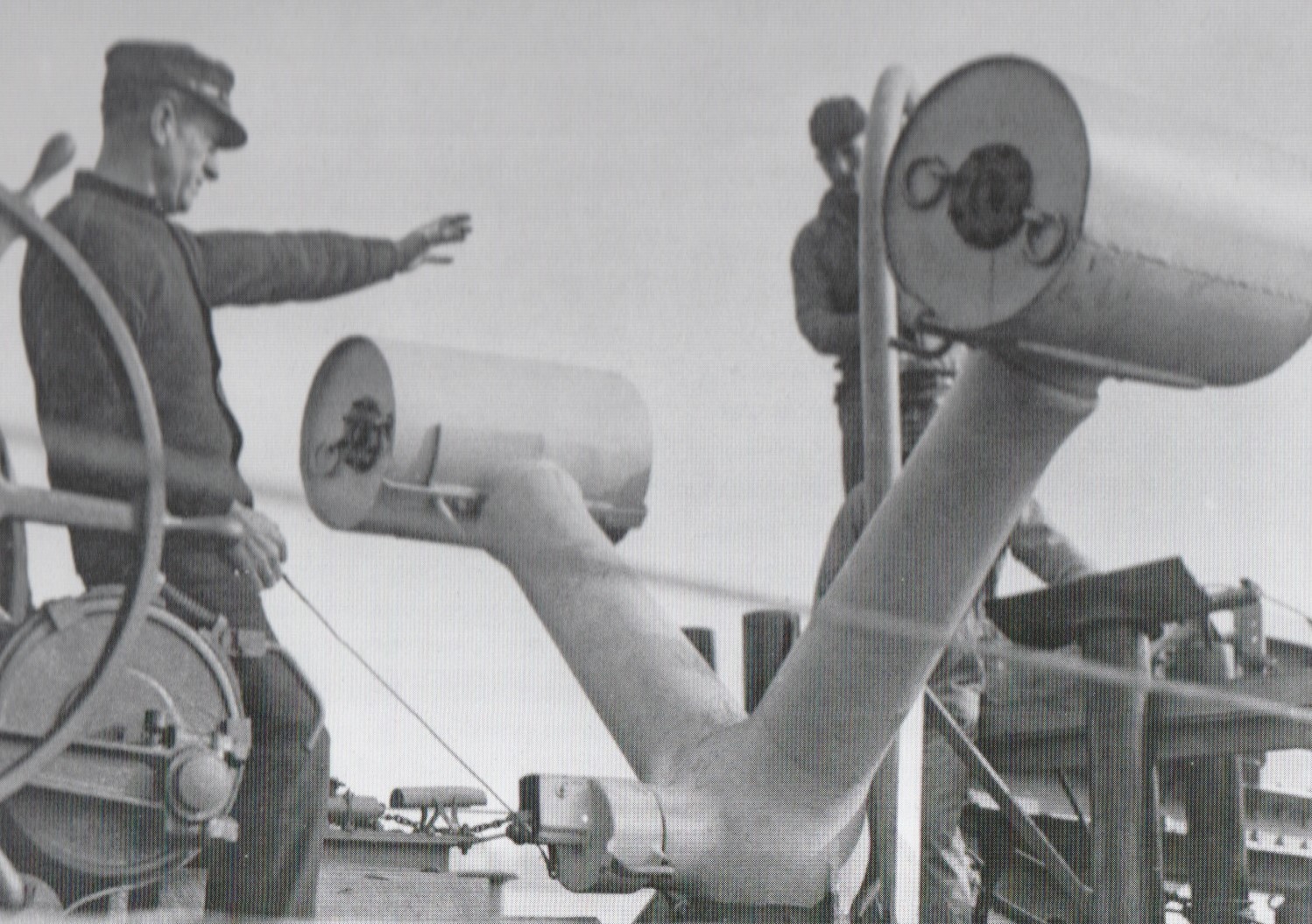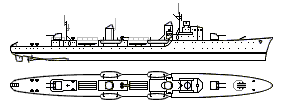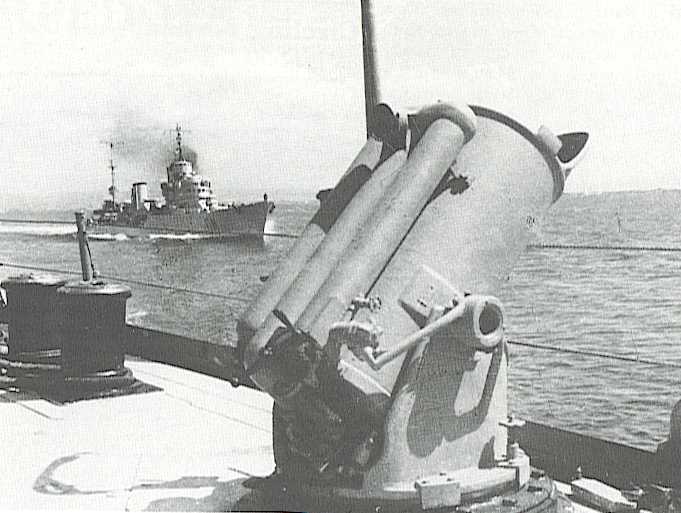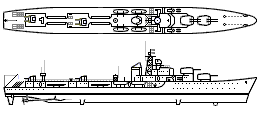[size=3]Cacciatorpediniere Italiani fra 1925 e 1930
[/size]
-The destroyer is “a small, fast, highly maneuverable warship armed gun, torpedoes and depth charges”
The roles of the destroyer are;
- Protect against torpedo attack from torpedo boats and other destroyers
- Protect against submarines
- Ablility to act offensively with torpedoes
- Protection against aircraft
These offensive and defensive roles have to be balanced on a small hull, which has proven increasingly problematic over the last few years.
1925 Navigatori Classe
The “Navigatori” class of destroyers should be more correctly termed as Esploratori Leggeri, that is to say, Light Scout Cruisers. They follow the pattern set by Quarto, Nibbio, Brindisi and Aquila. They were to be the eyes of the fleet. With the advent of the “Capitani Romani” esploratori, this role has passed, and now the Navigatori have reverted back to more traditional destroyer roles. They are rated as such under Cleito.
Their hull is quite short at 100m, but their beam and draught are greater than other destroyers giving them more stability for the heavy armament. There are 3 duple 130mm/50 mounts on the centreline which are hand-loaded and fire the 32kg HE shell.They are single purpose mounts. Anti-aircraft defense is comprised of a duple 37mm mount aft, and 13.2mm machine guns. There are 6 533mm torpedo tubes mounted in triples and a single rack for depth charges on the stern.
Their machinery produces 44.000shp which gives a speed of 34.5knts at normal load in a light seaway. The machinery is arranged in the unit principle, with 2B-T-2B-T. In practice, their sea speed has been found to be too slow, with a speed of about 29knts in state 4. In addition, they suffer from stability problems because of their heavy armament. Overall, they are considered to be very successful, but too slow.
1926 Turbine Classe
The Turbine class of 8 ships are in effect reduced versions of Navigatori. Their waterline dimensions have been slightly increased, but with far less draught making for a lighter ship. They are rated as 2nd class destoryers under Cleito.
Armament is very similar to Navigatori, but with the midships 130mm/50 being deleted and replaced with a quadruple 37mm/54 mount. Anti-aircraft gun power is increased and the stability problems have been rectified with the deletion of the extraneous 130mm mount. 6X533mm torpedoes and depth charges are still carried.
Machinery output is 40.000shp which gives a speed of 34.4knts in a light seaway, and again a speed of 29knts in state 4. The machinery has been grouped, with 2B-1B-1T-1T which lessens possible resistance to damage. Considering their size, they are relatively successful, but again need more speed. It is well to note that stability problems were solved whilst maintaining a useful range.
1927 Dardo Classe
Essentially, the Dardo Class were repeated versions of Turbine, the only differences being external. The funnels being grouped into one, and a more enclosed bridge being adopted. For the first time, there is also a fire-control director. It is of limited use, being only 3m long.
1928 Baleno
The next destroyer, Baleno was considerably different than previous ships. The hull was longer at 115m, and the draught reduced further. The displacement remained at around 1600tons.
Baleno's armament differs from previous classes. The 130mm/50 gun is the M1928 and fires a heavier 36kg shell. The mountings have high-angle capability, but do not have hoists, instead taking ammunition from deck lockers. This is unsatisfactory for sustained rate of fire, but it was not possible to include hoists on the design. The 36kg shell has been found to be too heavy for sustained firing at high angles, so a 28kg AA-fused shell is included for the first time also. The anti-aircraft armament is improved over Dardo with the inclusion of a triple 47mm/50 mount amidships and 6 Oerlikon FFL 20mm cannons. Offensive capability is also improved, with the use of 8 600mm torpedo tubes in quadruple mounts. There is extra capabilty against submarines, with depth charge projectors and towed torpedoes being used for the first time on a destroyer. A proper fire control director is included, a single Typo 2 being mounted above the bridge.
The machinery output is much lower than previous classes at 36.000shp for 33.9knts. However, Baleno is able to maintain this speed in state 4, giving a speed advantage of 5knts over the preceeding ships. Bunkerage is also increased to nearly 400tons as a result of possible oceanic operations. The machinery layout returns to Navigatori, with 2B-T-1B-T and two funnels. Stabilty is increased over the previous classes because of more attention being paid to layout.
1929 Ruggiero Classe
This next class of destroyers remedies all the problems of the preceeding classes at the expense of size. Unfortunately, it has proven that 2.600tons is necessary for a fully-able destroyer. Sadly, these ships must count as 2nd Class Cruisers under Cleito. That is not a particular problem, as Cleito has granted us plenty of tonnage in that category.
The armament of the Ruggiero's, named after frigates, is the tried and tested 130mm/50 gun. There is provision for 300 36kg shells, but usually 200x36kg and 100x28kg are carried. The mountings are different from Baleno's with completely enclosed turrets with hoists. They are again capable of high-angle gunfire, but sustained fire is possible due to the inclusion of hoists to below decks. Anti-aircraft armament has been able to be increased further. The larger hull is able to mount 4 triple 47mm/50 mounts. More Typo 2 fire control directors are provided. Again there are 2 quadruple 600mm torpedo tubes, but with reloads also availiable. The anti-submarine weaponary has been deleted. This may prove to be a mistake in future.
Machinery output is higher at 56.000shp for 35knts in state 4. It was felt as necessary to include 35knts speed in light of recent foreign developments. The Ruggiero are proper oceanic escorts, and have the range and ammunition storage for this role. The only problem is their size. Is it really worth it to have these escorts, especially when they cost twice as much as Baleno? Limited numbers of the type for special roles will be necessary, as there are certain roles that Baleno cannot fulfill. However, it would be more economical to adopt the Baleno-type as a future model for destroyers.








